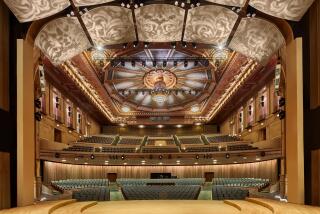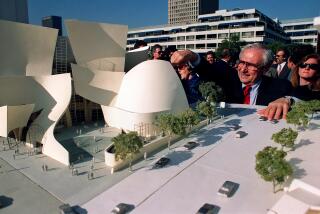Disney Hall’s updated organ will have more power in every note
Ten years in, the huge and powerful Opus 24 organ at Walt Disney Concert Hall needs a little sprucing up.
So Manuel Rosales, the man who helped design and build it, was back recently to bring it up to date. The $3-million, 40-ton pipe organ, which has served as the hall’s centerpiece since 2003, will have new systems and sounds ahead of the hall’s anniversary.
“That system was getting a little too slow for the best performers and all the things they can do,” said Rosales.
FULL COVERAGE: Walt Disney Concert Hall at 10
He remembered the design process for the organ with Frank Gehry. The architect’s first designs had pipes dangling from the ceiling and an organist in a cage halfway up the wall. “[Gehry] has great ideas, many of which are atrocious for building an organ,” Rosales said.
The architect’s re-imagining of the organ’s wood pipes as sculptures sprouting as high as 32 feet struck a chord with Rosales. And led to Gehry’s famous description of them as “French fries.”
However, Rosales said, “all the visual design, the structure, all the accouterments mean ultimately nothing if when you play this thing, it doesn’t blast you in the most fabulous way and has the subtle sounds that you need as well.” Otherwise, it’s just an artifact you look at and say, ‘What weird thing is that?’”
Organist Phil Smith, who plays the instrument’s 10 keyboards that sound a trio of 13-horsepower blowers, calls the Opus 24 “ultimate” in power and complexity.
TIMELINE: Walt Disney Hall through the years
“When you pull out all the stops and play something tutti super fortissimo, it’s unlike anything else,” said Smith, who also serves as organ conservator for the Los Angeles Philharmonic. “That’s when you find power in a way, when you’re seated in front of this enormous instrument and you’re using both hands, both feet, your whole body to play.”
In 2003 and 2004, Rosales spent 11 months with a team of two installing and fine-tuning the pipes, which range in size from a telephone pole to a pencil. But the technology behind the player and pipes “is now 25 years old in design,” he said. The updated digital sound system -- which will be ready before Hector Olivera’s organ recital Oct. 13 --will have more speed and features, including a pedal divide allowing organists’ different tones with the touch of a left, or right, foot and sostenuto to carry the instrument’s sound. Other organ performances this season will include a Halloween screening of the silent film “The Phantom of the Opera,” accompanied by Clark Wilson.
Additionally, the organ will soon be tuned wirelessly via an iPad and iPhone instead of Rosales and his team toting a keyboard and cable near the delicate pipes.
“There’s an app for everything,” Rosales said with a laugh.
More to Read
The biggest entertainment stories
Get our big stories about Hollywood, film, television, music, arts, culture and more right in your inbox as soon as they publish.
You may occasionally receive promotional content from the Los Angeles Times.










